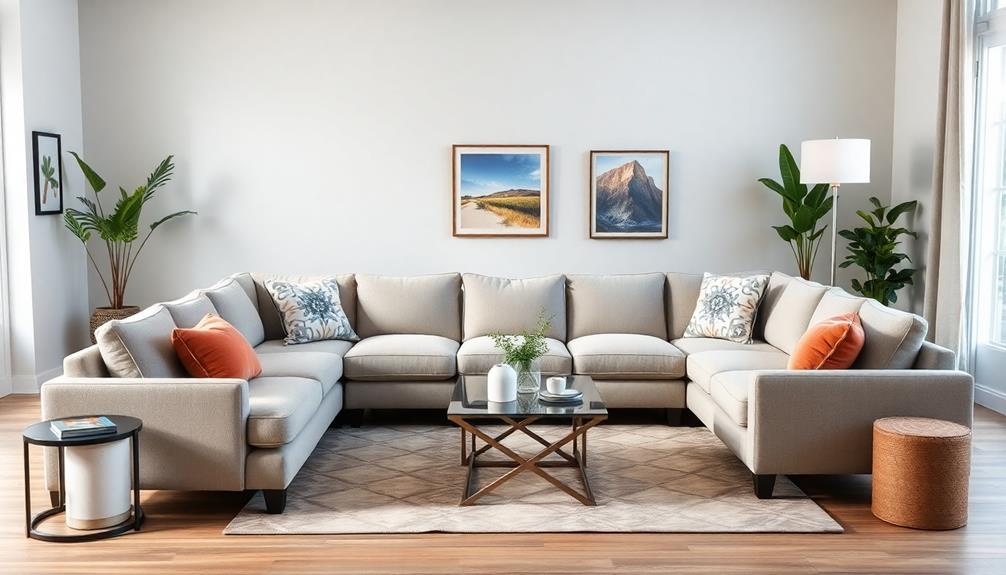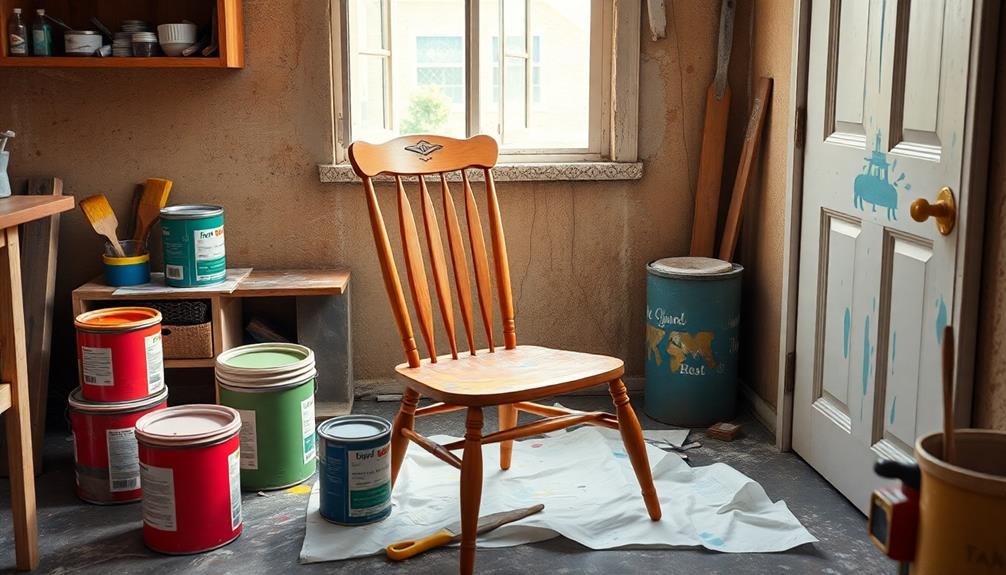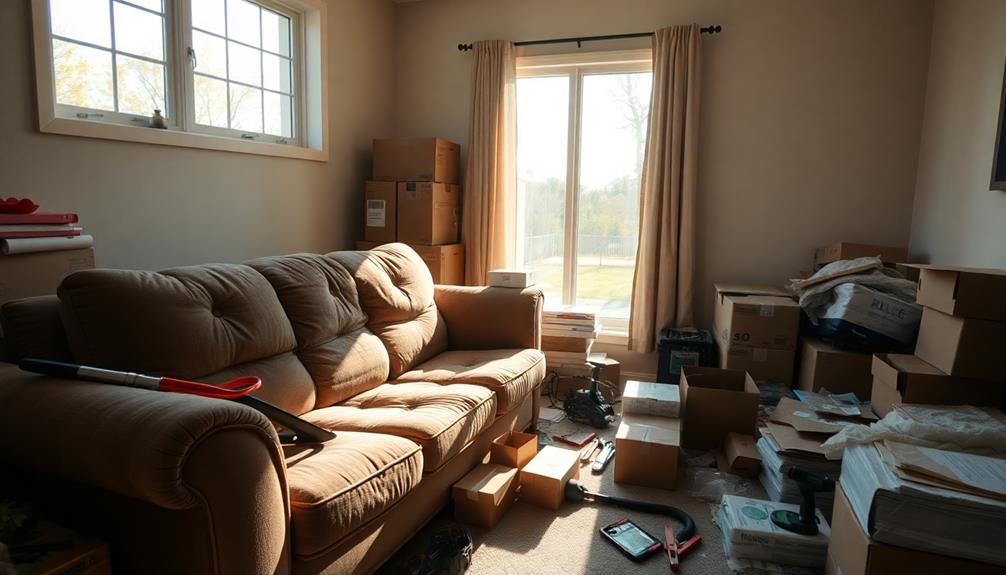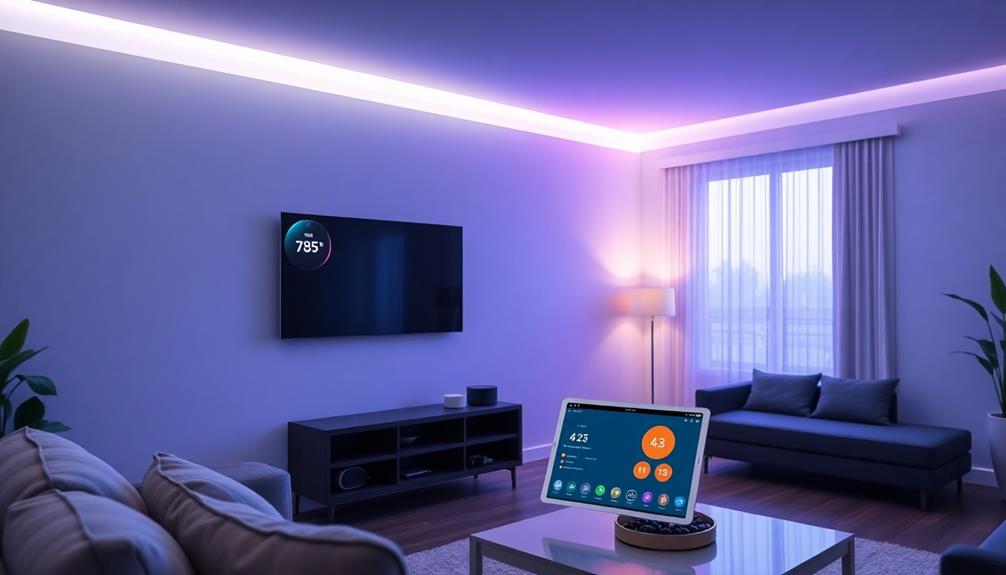To dismantle your sectional sofa, begin by clearing the surrounding area and taking off the cushions to make it easier to access the connection points. Use a screwdriver or wrench to carefully detach the sections, applying even pressure to prevent any damage. Once the pieces are separated, consider how to position them to maximize space and improve socializing areas. You can create L-shaped setups in corners or point the sections towards a central spot like a coffee table. After arranging, include decorative accents for harmony and coziness. Looking for suggestions on those final touches or problem-solving tips? There’s a lot more to discover!
Key Takeaways
- Clear the area around the sectional and remove cushions to make separation easier and protect surrounding furniture.
- Identify and inspect connection points such as screws or hooks for safe disassembly of the sectional.
- Utilize proper tools like screwdrivers and wrenches to detach sectional pieces without damaging them.
- Plan the new arrangement by measuring the space and strategically positioning the sectional to enhance room functionality and aesthetics.
- Incorporate complementary furniture and decorative elements to create a welcoming and cohesive seating area after rearranging the sectional.
Benefits of Sectional Sofas
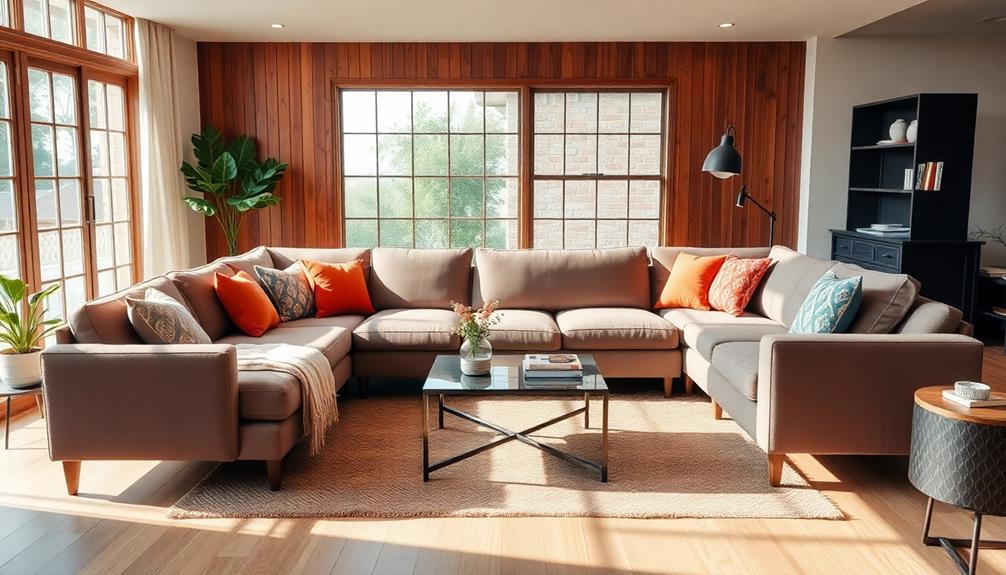
When it comes to furnishing your living space, sectional sofas stand out for their versatility and comfort. They can adapt to various room sizes and layouts, making them perfect for both cozy nooks and spacious living areas.
With their ample seating capacity, sectional sofas encourage social gatherings, creating a welcoming atmosphere for family and friends. Additionally, these sofas can be complemented by various design elements, such as DIY Fire Pit Ideas, to enhance the outdoor living experience when arranging your space.
Available in styles like L-shaped and U-shaped, sectional sofas enhance the aesthetic appeal of your room while serving as a functional focal point. Their modular design allows you to easily reconfigure the arrangement, so you can adapt your living space to changing needs and preferences over time.
This flexibility means you can rearrange your sectional to suit different occasions, whether it's a movie night or a festive get-together.
Moreover, the deep seating and plush cushions of sectional sofas provide superior comfort, making them ideal for relaxation. You'll find yourself sinking into the inviting embrace of your sectional after a long day.
All in all, sectional sofas combine style, functionality, and comfort, making them a smart choice for any living space.
Preparing for Separation
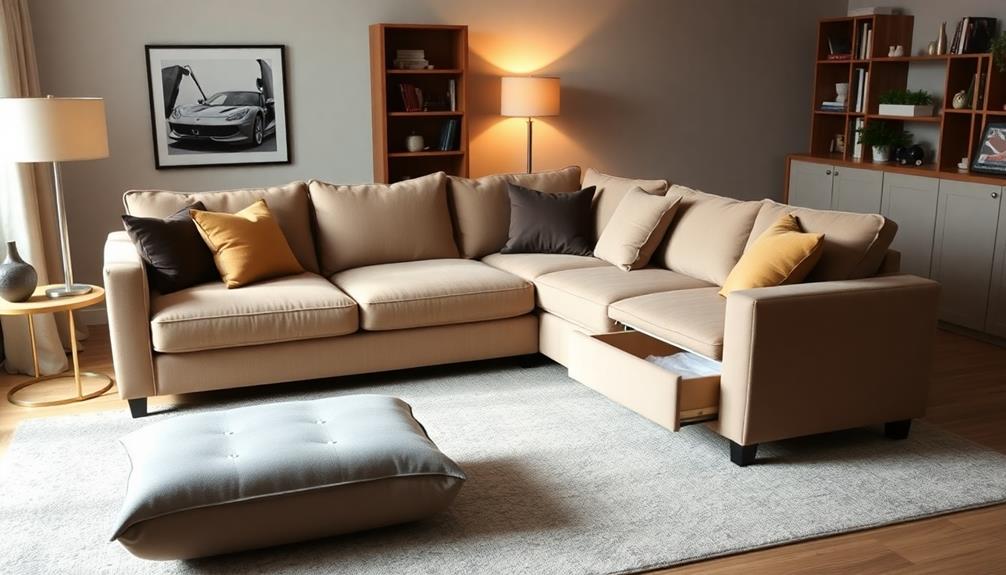
Before separating your sectional sofa, clear the area around it to give yourself plenty of room to work and avoid any damage.
It's also beneficial to reflect on how the arrangement of your sofa can enhance the functionality of your room, much like how energy-efficient appliances can improve your home's overall efficiency.
Next, take a close look at the sectional's design to find where the pieces connect, like screws or hidden fasteners. These connection points are crucial for ensuring the structural stability of the sectional and will guide you in piecing it back together. Make sure all hardware is accounted for, as missing components can lead to unsteady seating or gaps between sections. For more detailed instructions on how to assemble a sectional sofa, refer to the manufacturer’s manual or online guides specific to your model.
Clear the Area
To guarantee a smooth separation of your sectional sofa, start by clearing the area of any obstacles. Move any nearby furniture, decor, or items that could get in the way during the separation process. This not only protects your belongings from potential damage but also gives you ample space to maneuver the sofa sections.
Additionally, consider the impact of your choice on the overall room aesthetics and functionality, similar to how preventing cross-contact in kitchens guarantees a safe environment.
Next, remove the cushions from the sectional. This step lightens the load, making it easier to separate the pieces without straining yourself or risking damage to the sofa. Once the cushions are off, take a moment to inspect the sectional for any hidden fasteners or connectors. Identifying these connections helps you avoid unnecessary strain when you begin the separation.
Additionally, if you're planning to rearrange the room, measure the dimensions of both the sectional and the intended new arrangement spaces. This guarantees that you have a clear vision of how to fit the pieces into your space effectively.
With a clear area and a well-planned approach, you're ready to proceed with the separation and reconfiguration of your sectional sofa.
Assess Sectional Design
Understanding the design of your sectional sofa is essential for a smooth separation process. To effectively assess sectional design, you'll want to identify how the sofa sections connect and prepare for any challenges you might face.
Different arrangements can enhance the room's aesthetics, just as unique brewing methods can elevate your coffee experience.
- Inspect Connection Points: Look for screws, hooks, or connectors that hold the sections together.
- Check for Hidden Fasteners: Some sectionals may have concealed brackets or fasteners that could complicate your efforts.
- Measure Dimensions: Take measurements of each section to plan a comfortable layout for your room after separation.
- Clear the Area: Confirm you have enough space around the sectional to move the pieces safely.
Gather Necessary Tools
Once you've assessed the design of your sectional sofa, it's time to gather the necessary tools for a smooth separation process. Having the right tools on hand will make the job much easier and more efficient. Here's a quick list to help you get started:
| Tool | Purpose | Notes |
|---|---|---|
| Screwdriver | Remove screws holding sectional pieces together | Phillips or flathead as needed |
| Wrench | Loosen bolts or connectors | Adjustable wrench works well |
| Soft cloth/blanket | Protect sofa surfaces from scratches | Lay it down on the floor |
| Measuring tape | Plan your new arrangement | Measure space before moving |
| Flashlight | Illuminate hidden fasteners or connectors | Check under cushions and seams |
It's also wise to have a helper available, especially if your sectional is large. They can assist with lifting and keeping everything balanced, ensuring a hassle-free separation. By gathering these necessary tools, you're setting yourself up for success as you prepare to rearrange your room.
Steps to Separate
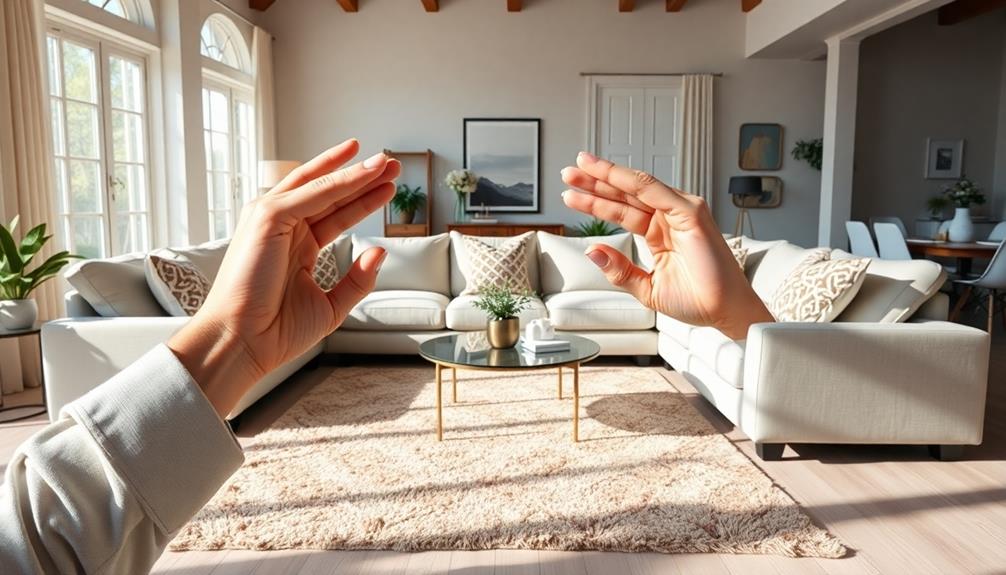
Before you start separating your sectional sofa, gather the necessary tools like a screwdriver or wrench.
If you have pets or allergies, consider using a best vacuum for dust removal to clean the area thoroughly once you've moved the sofa.
Make sure you've removed all the cushions to access the connection points easily.
With the right preparation and techniques, you can safely detach the sections without any hassle.
Preparation and Tools Needed
Clearing the area around your sectional sofa is essential for a smooth separation process. You want to guarantee there's enough space for movement and to avoid damaging surrounding furniture.
Proper preparation makes all the difference, so gather the tools needed before you start. This step aligns with the importance of effective preparation for maximizing outcomes in any design project, including furniture arrangement.
Here's a quick checklist of what you'll need:
- Screwdriver or Wrench: These help remove screws or connectors holding the sectional pieces together.
- Measuring Tape: Measure your sectional's dimensions and the intended arrangement space to plan effectively.
- Flashlight: Use this to locate any hidden fasteners or connectors that may be difficult to see.
- Helper: Always enlist someone to assist you; larger sections require coordination to maintain balance and prevent injury.
Once you've cleared the area and gathered your tools, take a moment to assess the sectional's design. Identify where the separation points are located, like hidden brackets or sliding connectors.
With everything ready, you'll be set to begin the separation process safely and effectively. This preparation also mirrors the concept of creating a mood board to visualize your space and enhance functionality, as discussed in mood boards essential.
Safe Separation Techniques
To safely separate your sectional sofa, start by removing all the cushions; this not only clears the area but also gives you better access to the separation handles. Next, locate the primary disconnect point, usually found at the square corner. Check for connectors like hooks, latches, or hidden clasps that may need to be disengaged.
| Step | Action |
|---|---|
| 1. Remove cushions | Clear the area and access separation handles. |
| 2. Identify disconnect point | Find hooks, latches, or clasps. |
| 3. Use tools if needed | Grab a screwdriver or wrench for screws. |
| 4. Apply even pressure | Gently pull sections apart to avoid damage. |
| 5. Get help for heavy parts | Enlist another person for balance and safety. |
Once you've disengaged all the connectors, gently pull apart the sections. Always apply even pressure, as this helps prevent damage. Finally, store the separated pieces in a safe area to avoid scratches while you plan the new arrangement for your room. By following these steps, you can effectively and safely separate a sectional sofa.
Arranging the Room
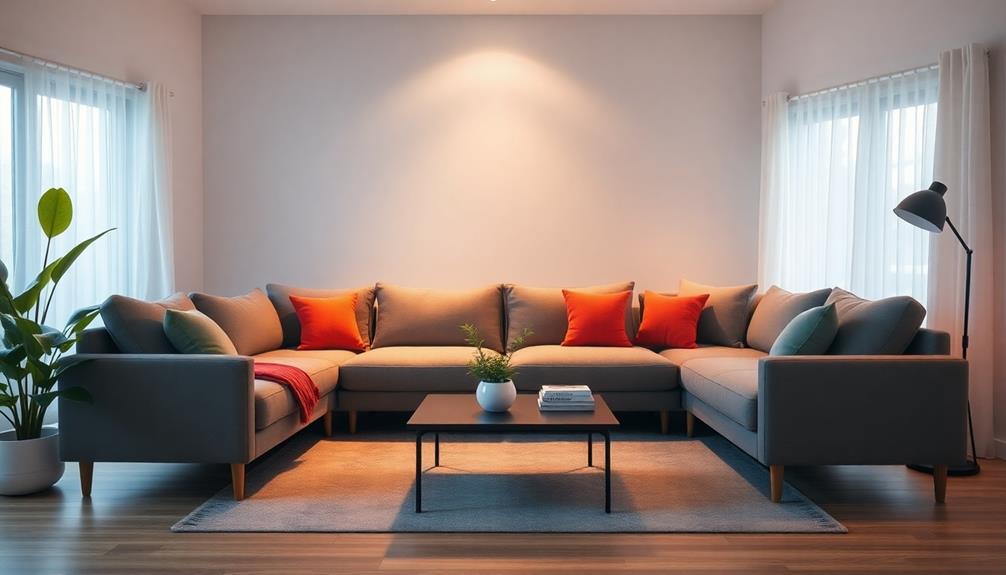
Arranging a room with a sectional sofa can transform your space into a cozy retreat, especially when you incorporate elements from modern farmhouse decor trends that emphasize natural materials and neutral palettes.
To make the most of the sofa in your living area, consider these key tips:
- L-shaped Configurations: Use the sectional pieces to fill corners effectively, turning unused spaces into inviting areas for relaxation or conversation.
- Focus on Focal Points: Position the sectional around focal points like a fireplace or TV. This creates cozy conversation zones and enhances the room's functionality.
- Clear Pathways: Maintain a clear pathway between furniture. This guarantees easy movement throughout the space, allowing for seamless shifts during gatherings.
- Complementary Furniture: Incorporate coffee tables and accent chairs to balance the visual weight of the sectional. This creates a cohesive look in the room.
Don't forget to add decorative elements like rugs and lighting to define your seating area.
These touches not only enhance the overall aesthetic but also make the space feel warm and inviting.
Final Touches
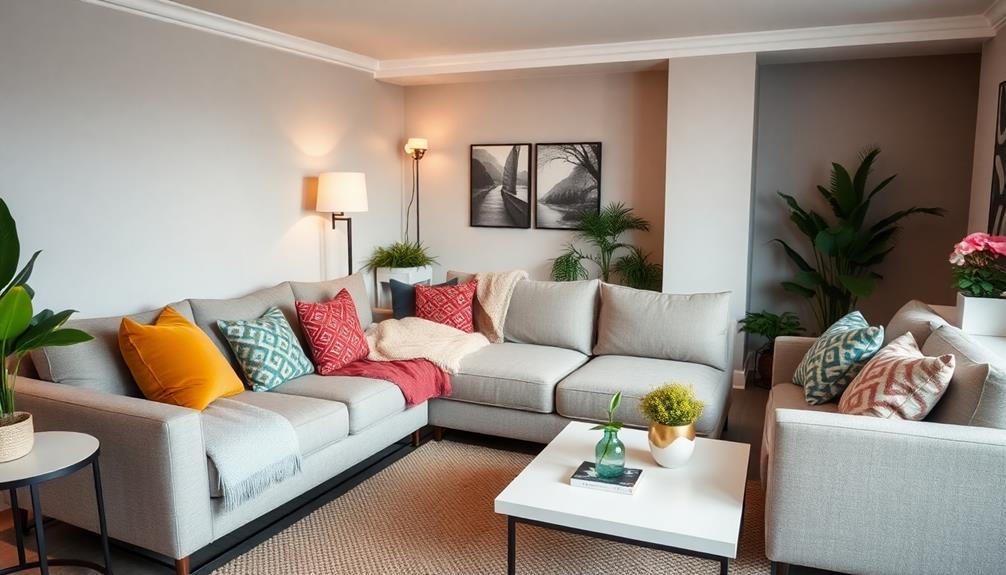
Once you've organized your sectional sofa and surrounding furniture, it's time to focus on the final touches that bring the space together.
Start by adding cushions and throws in complementary colors to enhance comfort and visual appeal around your sofa. This'll create a cozy atmosphere that invites relaxation.
Consider incorporating elements that reflect local food culture or personal interests, such as best restaurants that inspire your decor choices, which can also add a unique touch to the arrangement.
Next, consider adjustable lighting options, like floor lamps or table lamps, to highlight your sectional arrangement and create a warm ambiance in the room. Proper lighting can make all the difference in how the space feels.
Don't forget to adjust the placement of other furniture pieces, like side tables and accent chairs, based on usage patterns. This guarantees a functional and inviting space around your sofa.
To achieve balance and symmetry, incorporate decorative elements such as rugs, artwork, or plants. These touches help unify the look of the separated sections and add personality to the room.
Furniture Arrangement Tips
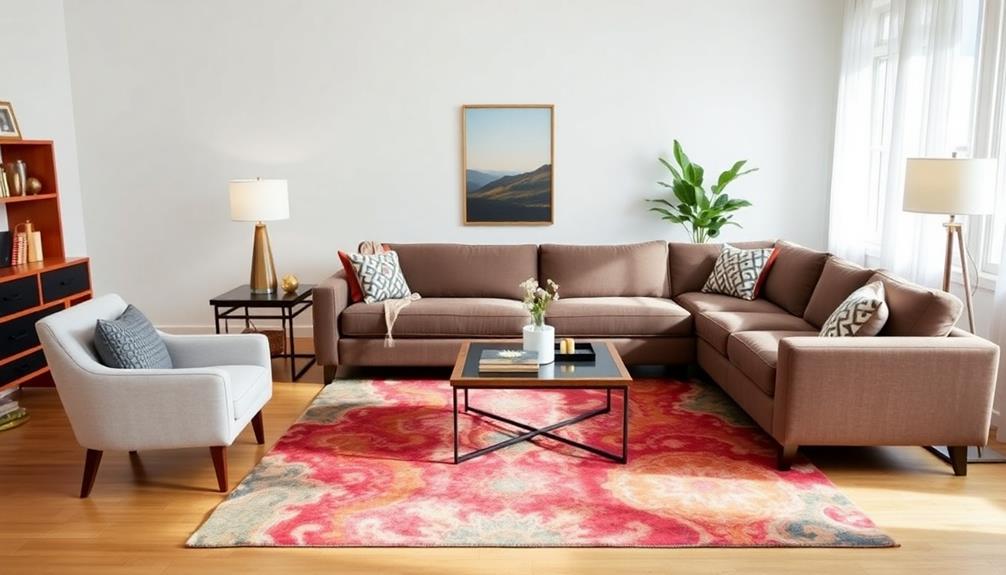
When arranging your room with a sectional sofa, focus on optimizing space and enhancing conversation areas.
Incorporating elements of design thinking can help you creatively address room layout and user experience. Position your sectional to fill corners efficiently and create inviting spots for gatherings.
Remember to leave enough space for movement and incorporate complementary furniture to make the layout functional and welcoming. Additionally, consider the flow of traffic to ensure that everyone can easily navigate the room without feeling cramped. When arranging furniture in small spaces, opt for multi-functional pieces that provide storage or serve multiple purposes while maintaining an open feel. Thoughtfully positioning mirrors can also enhance the perception of space by reflecting light and creating a more expansive atmosphere.
Optimizing Space Utilization
To make the most of your space, think strategically about how you position your sectional sofa. Using it to arrange your room effectively can transform it into a functional and inviting area. Here are some tips to optimize space utilization:
- Position L-shaped sectionals in corners: This maximizes unused space and creates cozy reading nooks or relaxation areas. Additionally, consider incorporating aesthetic bedside lamps to enhance the ambiance in these cozy spots.
- Arrange sectional pieces to face each other: A parallel layout fosters conversation. Place a coffee table between them for easy access to drinks and snacks.
- Utilize armless sections against walls: This creates a sleek look, turning them into slipper sofas that add seating without overwhelming your room.
- Incorporate rugs to define seating areas: Choose rugs that complement the sectional's color and style, enhancing the overall design for a cohesive look.
Also, maintain clear pathways around your furniture. This facilitates movement and avoids clutter, creating a more open and inviting atmosphere.
Enhancing Conversation Areas
Creating an inviting conversation area in your living space can greatly enhance social interactions. Start by positioning your sectional sofa so that the longest section runs parallel to a coffee table. This arrangement promotes easy interaction among seated guests, making it the focal point of your gathering.
To foster openness, utilize armless sections of the sectional, allowing for smooth flow and easier movement in and out of the space.
To balance the arrangement, consider adding accent chairs around the sectional. This extra seating gives guests more options to join in the discussion while maintaining a cozy atmosphere.
To define the conversation area further, use a decorative area rug that encompasses all seating pieces. This will help ground the space and create a cohesive look that invites everyone in.
Lastly, guarantee there's at least 18 inches of space between the sectional and other furniture pieces, like side tables. This room to maneuver keeps the area comfortable and welcoming, encouraging lively conversations and connections among friends and family.
Maintenance and Care
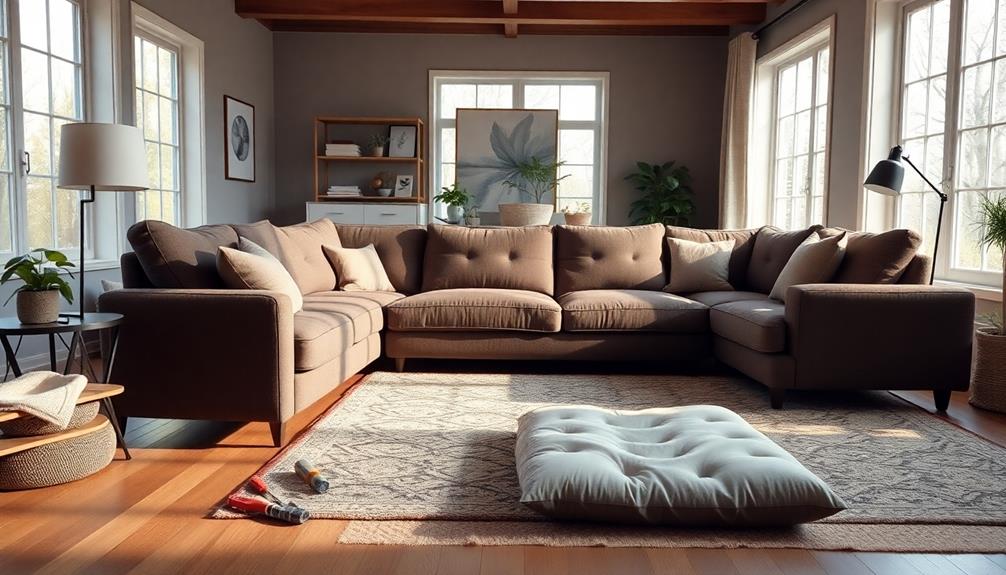
Maintaining the longevity and appearance of your sectional sofa requires regular attention and care. By following these simple steps, you can keep your sofa looking its best for years to come:
- Vacuum Regularly: Make it a habit to vacuum your sectional sofa to remove dust and debris. This helps maintain the fabric's appearance and prolongs its life.
- Spot Clean Stains: Address stains immediately with appropriate cleaners. Quick action prevents permanent damage and discoloration of the fabric.
- Rotate Cushions: Periodically rotate your cushions to guarantee even wear. This practice helps maintain their shape and comfort over time.
- Follow Care Instructions: Always adhere to the manufacturer's care instructions for specific cleaning methods. Knowing your sofa's fabric type and recommended products is essential to avoid damage.
Additionally, consider professional cleaning every few years to restore your sofa's appearance and eliminate deep-seated dirt and allergens.
Common Concerns
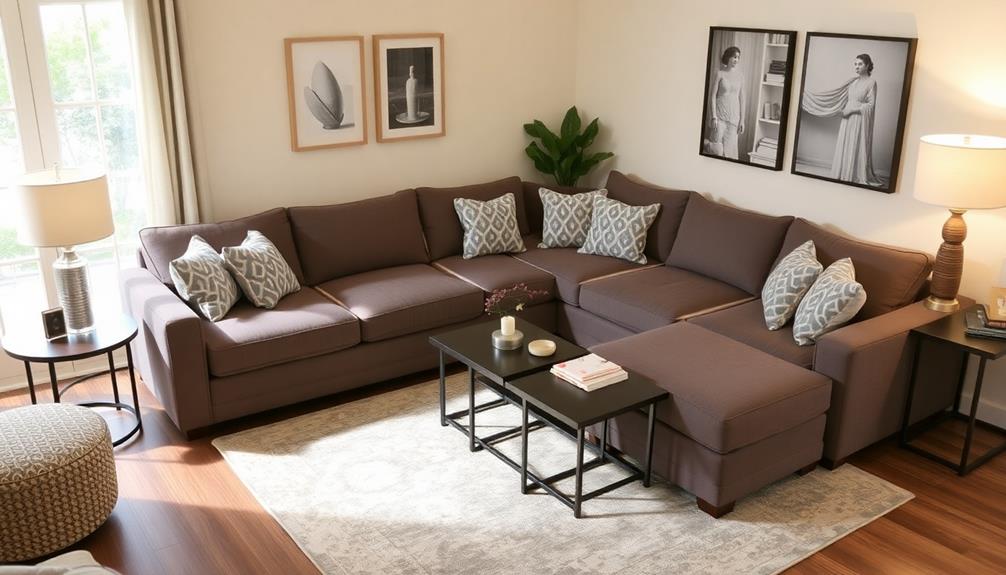
When separating a sectional sofa, you'll likely encounter several common concerns that can affect both its functionality and appearance. One major issue is stability; after you separate the pieces, stability issues may arise, so handle each section carefully to keep them balanced and secure.
Another concern is uneven wear. If one piece gets used more frequently than others, it might wear out faster, impacting its longevity and comfort. Keeping an eye on usage can help mitigate this problem.
It's also important to track any connectors or fasteners during the separation process. Losing these components can make it difficult to reassemble your sectional sofa later, leading to frustration.
Lastly, consider the aesthetic impact. The way you separate your sofa can change the room's visual harmony, so take time to plan your arrangement thoughtfully.
Space limitations in smaller rooms might restrict your options, so measure the dimensions before you move your sofa. By addressing these common concerns, you can guarantee that your sectional remains both functional and visually appealing in its new arrangement.
Professional Assistance
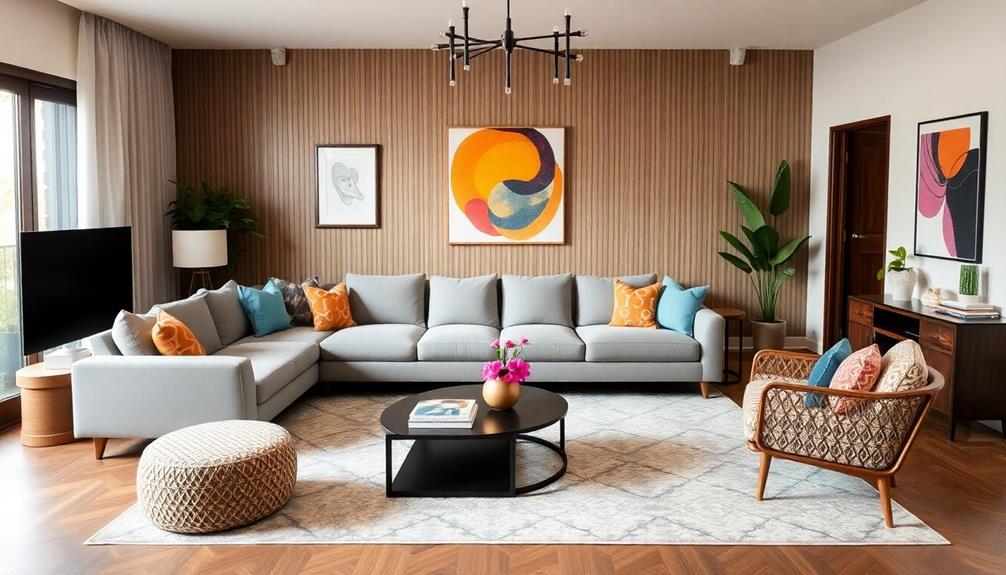
If you're feeling uncertain about separating your sectional sofa, seeking professional assistance can make the process smoother and more efficient.
Here's how experts can help:
- Furniture Specialists: They provide expert guidance for complex sectional separations, ensuring everything's done safely and without damage.
- Upholsterers: These pros can advise you on maintaining the fabric's integrity during disassembly and assist with any necessary repairs or cleaning afterward.
- Interior Designers: Consulting with them can lead to ideal arrangements for your separated sectional, enhancing both functionality and aesthetic appeal in your room.
- Moving Services: They can assist in safely transporting the separated pieces, especially larger or heavier sections, minimizing the risk of injury or damage during relocation.
Additionally, don't forget about furniture retailers. They might offer replacement parts or repair services if any connectors or components get lost or damaged during the separation process.
DIY and Upcycling Ideas
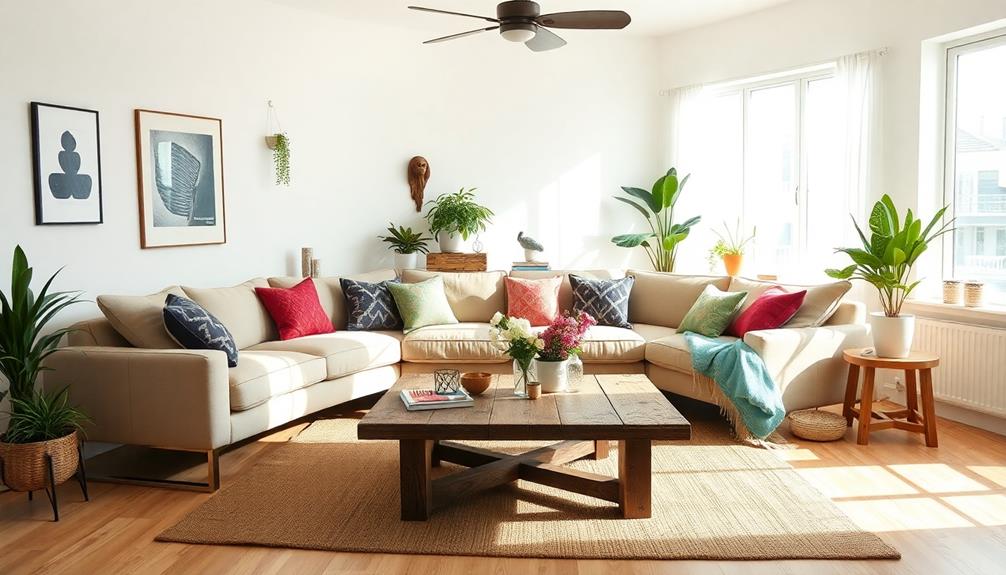
Transforming your sectional sofa into unique, functional pieces can be a rewarding DIY project. Start by repurposing leftover sectional pieces; for instance, turn a chaise section into a stylish bench or a corner piece into a unique side table. This not only adds functionality but also helps you showcase your creativity.
Next, utilize fabric from the sectional to create DIY throw pillows or cushions. This adds a personal touch to your decor while ensuring you make the most of materials you already have.
If you want to enhance storage, consider modifying components like converting an ottoman into a lift-top storage unit. This way, you can keep your space organized while maintaining style.
Don't forget about aesthetics! Explore painting or refinishing options for the separated pieces to give them a fresh look that complements your current room color scheme.
Frequently Asked Questions
Can a Sectional Couch Be Separated?
Yes, you can separate a sectional couch. Most are designed with connectors that make disassembly easy. Just check for screws or brackets, then clear the area to avoid damage while you're moving the pieces.
How Do You Divide a Room With a Sectional?
You'd think dividing a room's easy, right? But with a sectional, you can create distinct zones by positioning it wisely, using accent chairs and rugs to enhance flow, while clearly marking each area for interaction.
How to Arrange a Sectional Sofa in a Small Room?
To arrange a sectional sofa in a small room, place it in a corner, use armless pieces for flow, and incorporate multi-functional furniture. Light colors can also help create an open, inviting atmosphere.
Can Sectional Couches Be Rearranged?
Yes, you can definitely rearrange sectional couches! They're designed for flexibility, allowing you to create various configurations that suit your space and style. Just detach the sections and experiment with different layouts to enhance your room's functionality.
Conclusion
To sum up, separating your sectional sofa can transform your space dramatically. Did you know that 65% of homeowners feel more satisfied with their living areas after rearranging furniture? By following the steps outlined, you can create a fresh, inviting atmosphere that reflects your style. Remember to keep your sofa's maintenance in mind, and don't hesitate to get creative with upcycling ideas. A little effort can lead to a big change, enhancing both comfort and aesthetic appeal in your home.
